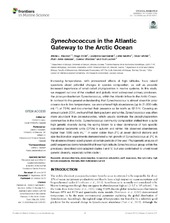| dc.contributor.author | Paulsen, Maria Lund | |
| dc.contributor.author | Doré, Hugo | |
| dc.contributor.author | Garczarek, Laurence | |
| dc.contributor.author | Seuthe, Lena | |
| dc.contributor.author | Müller, Oliver | |
| dc.contributor.author | Sandaa, Ruth-Anne | |
| dc.contributor.author | Bratbak, Gunnar | |
| dc.contributor.author | Larsen, Aud | |
| dc.date.accessioned | 2017-04-27T08:32:41Z | |
| dc.date.available | 2017-04-27T08:32:41Z | |
| dc.date.issued | 2016-10-05 | |
| dc.Published | Paulsen ML, Doré, Garczarek L, Seuthe L, Müller O, Sandaa R, Bratbak G, Larsen A. Synechococcus in the Atlantic Gateway to the Arctic Ocean. Frontiers in Marine Science. 2016;3:191 | eng |
| dc.identifier.issn | 2296-7745 | en_US |
| dc.identifier.uri | https://hdl.handle.net/1956/15716 | |
| dc.description.abstract | Increasing temperatures, with pronounced effects at high latitudes, have raised questions about potential changes in species composition, as well as possible increased importance of small-celled phytoplankton in marine systems. In this study, we mapped out one of the smallest and globally most widespread primary producers, the picocyanobacterium Synechococcus, within the Atlantic inflow to the Arctic Ocean. In contrast to the general understanding that Synechococcus is almost absent in polar oceans due to low temperatures, we encountered high abundances (up to 21,000 cells mL−1) at 79°N, and documented their presence as far north as 82.5°N. Covering an annual cycle in 2014, we found that during autumn and winter, Synechococcus was often more abundant than picoeukaryotes, which usually dominate the picophytoplankton communities in the Arctic. Synechococcus community composition shifted from a quite high genetic diversity during the spring bloom to a clear dominance of two specific operational taxonomic units (OTUs) in autumn and winter. We observed abundances higher than 1000 cells mL−1 in water colder than 2°C at seven distinct stations and size-fractionation experiments demonstrated a net growth of Synechococcus at 2°C in the absence of nano-sized grazers at certain periods of the year. Phylogenetic analysis of petB sequences demonstrated that these high latitude Synechococcus group within the previously described cold-adapted clades I and IV, but also contributed to unveil novel genetic diversity, especially within clade I. | en_US |
| dc.language.iso | eng | eng |
| dc.publisher | Frontiers | en_US |
| dc.relation.ispartof | <a href="http://hdl.handle.net/1956/17362" target="blank">Microbial dynamics in high latitude ecosystems. Responses to mixing, runoff and seasonal variation a rapidly changing environment</a> | en_US |
| dc.rights | Attribution CC BY | eng |
| dc.rights.uri | http://creativecommons.org/licenses/by/4.0 | eng |
| dc.subject | picocyanobacteria | eng |
| dc.subject | picoeukaryotes | eng |
| dc.subject | temperature adaptation | eng |
| dc.subject | petB sequences | eng |
| dc.subject | Flow cytometry | eng |
| dc.subject | high latitude ecosystems | eng |
| dc.subject | Svalbard | eng |
| dc.subject | West Spitsbergen Current | eng |
| dc.title | Synechococcus in the Atlantic Gateway to the Arctic Ocean | en_US |
| dc.type | Peer reviewed | |
| dc.type | Journal article | |
| dc.date.updated | 2017-02-17T13:09:38Z | |
| dc.description.version | publishedVersion | en_US |
| dc.rights.holder | Copyright 2016 The Author(s) | en_US |
| dc.identifier.doi | https://doi.org/10.3389/fmars.2016.00191 | |
| dc.identifier.cristin | 1386144 | |
| dc.source.journal | Frontiers in Marine Science | |
| dc.relation.project | Norges forskningsråd: 225956 | |
| dc.relation.project | Norges forskningsråd: 226415 | |

